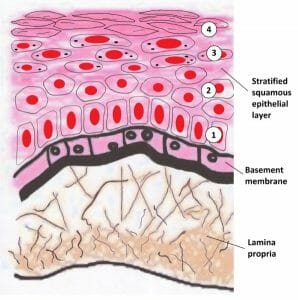Stratified Squamous Epithelium Definition
Stratified squamous epithelia are tissues formed from multiple layers of cells resting on a basement membrane, with the superficial layer(s) consisting of squamous cells. Underlying cell layers can be made of cuboidal or columnar cells as well.
Functions of Stratified Squamous Epithelia
Epithelia consisting of multiple cell layers are generally found in regions where there is mechanical or chemical abrasion and stress and these tissues protect underlying structures from harm. Stratified squamous epithelia are found in nearly every organ system where the body comes into close contact with the outside environment – from the skin to the respiratory, digestive, excretory and reproductive systems. They also protect the body from desiccation and water loss.
Types of Stratified Squamous Epithelia
These tissues can be classified as keratinized or non-keratinized based on the cytoskeletal structures found within the cell.
Keratinized tissues are important where there is physical abrasion as well as the possibility of desiccation and water loss. Keratinized cells are specially structured to be waterproof and reduce evaporation from underlying tissues and are therefore an important part of the epidermis or external skin. They are also found in the oral cavity where eating, speaking and breathing could lead to significant loss of water. Non-keratinized epithelia usually secrete mucus as an additional protective and lubricating layer and are seen in the esophagus and in parts of the female reproductive system.
Some organs, such as the anus, contain both keratinized and non-keratinized stratified squamous epithelia. Additionally, the amount of keratin deposition can vary depending on the level of abrasion. For instance, in people with a history of tobacco or alcohol abuse, the respiratory and digestive epithelia could become excessively keratinized. Even non-keratinized epithelium, such as the buccal mucosa, can generate calloused tissue as a result of habitual clenching or grinding of teeth.
The development of keratinized tissue involves the loss of cell viability. The cells closest to basement membrane undergo mitosis and form the proliferative population. These cells differentiate, with changes in protein expression, increasing presence of cytoskeletal elements and extensive cross-linking to the extracellular matrix. During differentiation, these cells also secrete glycolipids that fill interstitial spaces and isolate themselves. This is followed by nuclear disintegration and cell death. The external, dead layers of cells are periodically sloughed off and replaced.
Examples of Stratified Squamous Epithelia
In the digestive system, this tissue type is found on upper surface of the tongue, the hard palate of the mouth, the esophagus and anus. It is also common in the female reproductive system and is seen in the vagina, cervix, and labia majora. Additionally, it is a major part of the mammalian integumentary system, forming the external skin. It is also found in the cornea of the eye and maintains the integrity of the delicate tissues of the eye. This tissue type is also are present in the respiratory system, especially in the oropharynx, which is present just behind the mouth and therefore comes into contact with food. Finally, stratified squamous epithelia are seen at the urethra, where urine exits the body.
Example I: Vaginal Epithelium
The vagina connects the cervix of the uterus to the external genital structures in mammalian females. The vaginal epithelium plays an important role in maintaining sexual and reproductive health, especially among animals that undergo menstrual and estrous cycles. The thickness and keratinization of the squamous epithelium found in this organ are subject to changes during a reproductive cycle and can influence fertility as well as susceptibility to infections. For instance, hormone levels influence the number of cell layers in this epithelium. This results in the epithelium changing morphology with the maximum thickness being achieved during estrus or ovulation. During menses or diestrus, the epithelium is at its thinnest. Additionally, research on rhesus monkeys indicates that juvenile and geriatric females have thin epithelia with minimal keratin presence when compared to mature cycling individuals. There are also major changes to this epidermal tissue during pregnancy and before childbirth to facilitate the movement of the fetus through the muscular walls of the vagina.
Example II: Masticatory Mucosa
Oral mucosa lines the inside of the mouth and consists of stratified squamous epithelium as well as the connective tissue underneath. The mouth contains both keratinized as well as non-keratinized stratified squamous epithelium. The parts of the mouth that feel a little rough such as the upper surface of the tongue and the hard palate at the roof of the mouth contain keratinized epithelia. These tissues are formed by four layers: the basal layer, the spinous layer, the granular layer and the most superficial keratinized layer. The basal layer remains in contact with the basement membrane, and keratinization begins with the spinous layer. The third layer is distinguished by the appearance of lipids and proteins that are secreted into the extracellular matrix. The keratinized or corneal layer consists of dead cells containing abundant keratin, but no nucleus or cytoplasm.

The rest of the mouth, such as the mucosa lining the cheeks, or the inner lining of the lips feel softer, and more moist. These are lined by non-keratinized epithelial tissue.
Related Biology Terms
- Diestrus – A period of sexual inactivity between two estrus cycles.
- Glycolipid – Lipids that have a carbohydrate attached to them through a glycosidic linkage.
- Intermediate Filaments – Long fibrous cytoskeletal components that are made from various proteins, with a thickness in between actin and microtubule filaments.
- Keratinocyte – Epidermal cell that can produce keratin.
Quiz
1. Which of these is true about stratified squamous epithelia?
A. They are made exclusively by layers of keratinized squamous cells
B. They are present in the oropharynx as well as in the alveoli
C. The thickness of this tissue in every organ depends on hormone levels in females
D. None of the above
